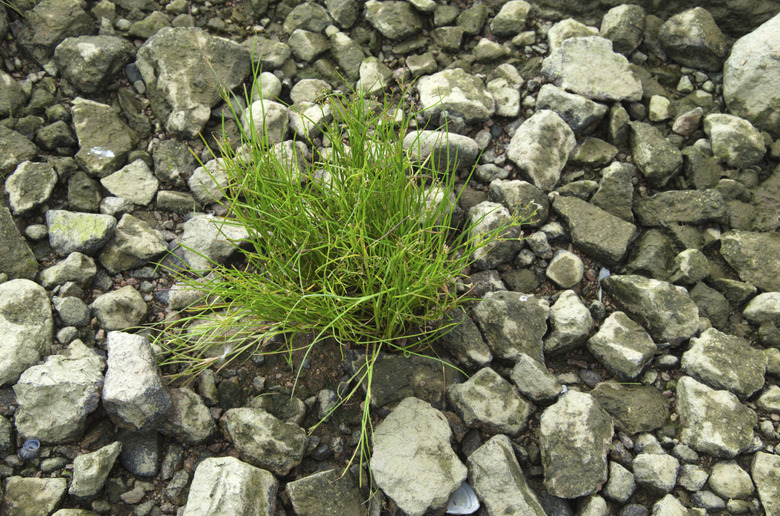How To Grow Grass On Gravel
If you've ever mulched a landscape bed with gravel, you know that grass — and weeds — can grow in gravel. And that gravel compacts the soil underneath. But if you've inherited a yard full of gravelly "clean fill," you can convert it to turf, providing you're willing to invest some time, money and water in the project.
Preparing the Site
Preparing the Site
You can grow turfgrass on gravel, but keep in mind that you will have to provide what gravel won't, namely nutrients and moisture. Give the gravel a fresh grade, crowning to guide runoff away from buildings. While grading, rough up the surface to provide new grass roots a grip. A top dressing of sand or river silt helps slow drainage and provide a finer texture to shelter germinating seeds and new roots. Start your lawn during your area's rainiest season, because seeds will need constant moisture to germinate. In the upper Midwest, for example, late spring is rainy, but in the West, fall may bring more favorable rains.
Choose Knowledgeably
Choose Knowledgeably
Once your site is graded and prepped, invest in a soil test kit and take it to your local extension or lab. Only a soil test can tell you what nutrients are present — and absent — in your rocky soil and suggest the right fertilizing program. If you take your soil to an agricultural extension, its specialists can also suggest grasses that have the best chance of survival on your gravel. Choose a drought-resistant grass such as a tall fescue (Festuca arundinacea) or red fescue (Festuca rubra), both hardy in U.S. Department of Agriculture plant hardiness zones 3 through 6, switchgrass (Panicum virgatum), hardy in USDA zones 5 through 9 — or the recommendation of your extension agent.
Starting Right
Starting Right
For best germination, plant fescues and other cool season grasses when soil temperatures rise above 60 degrees Fahrenheit and switchgrass and other warm season grasses when soil temperatures stay above 70 degrees. Soak the area thoroughly before seeding and scatter seed exceeding the recommended rate — if directions suggest 4 pounds of seed per 1,000 square feet, lay down 5 or 6 pounds over the same area. Keep seed continually moist until it grows to 1 inch tall, then supplement rain so grass gets 1 inch of water per week. Wait until the grass is about 3 inches tall to mow and never mow lower than 2.5 inches on gravel. Fertilize annually or spring and fall based on needs established by soil tests.
Beating New Construction Blues
Beating New Construction Blues
Clean fill contains little organic matter, so even your best efforts might produce quick cover but a short-lived lawn. Make seeding success is made more permanent — and you'll save considerable annual labor — by working 1 to 2 inches of a combination of well-rotted compost and topsoil into the top 4 inches of clean fill. If the clean fill is clay-heavy, use only topsoil to break it up. Add 1 or 2 or more inches of topsoil as a bed for the grass seed.
References
- Cornell Cooperative Service of Rensselaer County: Amending Sandy, Gravelly or Clayey Soils to Grow a Lawn
- Colorado State University Extension: Managing Soil Tilth: Texture, Structure, and Pore Space
- University of Alaska Fairbanks Cooperative Extension Service: Planting Grass on Gravel Runways in Alaska
- Maine Erosion and Sediment Control: Gravel Pit Reclamation
- U.S. Department of Agriculture: Managing Turfgrass to Reduce Wildlife Hazards at Airports
- U.S. Department of Agriculture Natural Resources Conservation Service: Gravel Pit and Other Sandy and Droughty Site Renovation Trials and Experiences in New Hampshire
- Missouri Botanical Garden: Festuca Arundinacea "Jaguar 3"
- Missouri Botanical Garden: Festuca Rubra "Pennlawn"
- Missouri Botanical Garden: Panicum Virgatum "Cheyenne Sky"
- University of Illinois at Urbana-Champaign Turgrass Program Extension: Turfgrass Establishment
